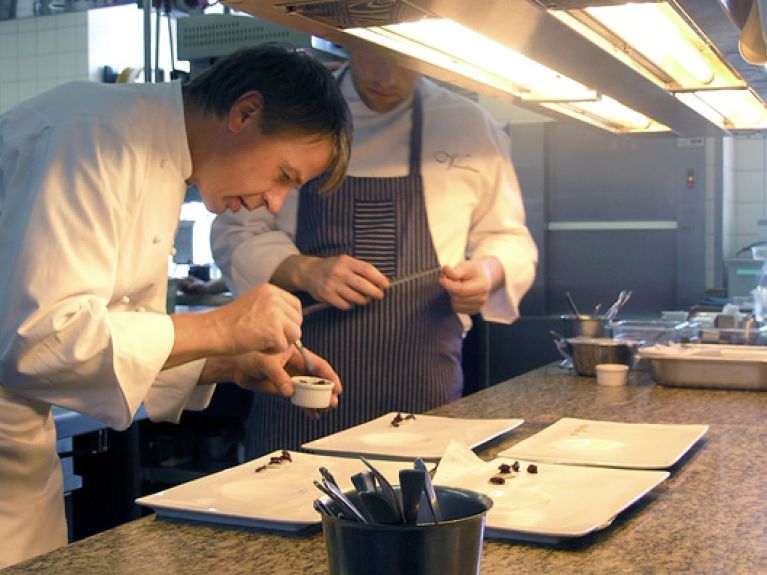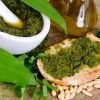Cooking and conscience
How tastes and restaurants are changing in Germany.

Trends in new German cooking
Root vegetable stews. Curly kale, sauerkraut, potato dumplings. At Christmas a goose braised in the oven for hours. This is traditional German cooking. Yesterday – and often still today. Many love it, but not all. In Germany there is a generation of primarily younger consumers, shaped by international experiences and influences, who enjoy eating sushi and Thai curry at least as much as schnitzel. There is cheap food, but there is also high quality consciousness, which goes hand in hand with a new and deep love of the country and rural life. And there are two topics that crop up in virtually every debate on food and drink in Germany, namely the ethics of consumption and restoring the value of good old regional food. And chefs are involved as well.
Lobster, tamarind & tomato. Australian truffle, palm heart, water chestnut: excerpts from the menu in Tim Raue’s restaurant in Berlin. And on Harald Rüssel’s menu in his restaurant in a side valley of the Mosel: fillet of char, sauté potatoes and chanterelles, and chive jus. Both restaurants are run by award-winning chefs. Harald Rüssel has 18 points in the Gault Millau restaurant guide and has had a Michelin star for 20 years. Tim Raue has had three stars since 2012. To eat at both establishments, you have to travel right across Germany. There are 700 kilometres between them, but that is not all. Indeed, their philosophies are fundamentally different; they are something like the opposite ends of what is a lasting trend in high-end gastronomy: for one the whole world is his market, for the other his own country.
According to a recent report by an agronomist at the University of Hohenheim, who surveyed around 2,000 men and women on their eating habits, 60% of Germans are essentially prepared to eat less meat. Other academics claim that meat consumption falls as levels of education and income rise, and have identified an image shift: whereas, after the Second World War, meat was a luxury, today it is a mass product. And consuming it is increasingly seen as a sign of membership of lower social strata. This is a bold hypothesis, with insufficient figures to prove it, but it points to another trend. “I am a flexitarian” – this new coinage refers to people who do not do without meat entirely, but take a flexible approach to their meat consumption. Their decision is often politically motivated. From their perspective, eating less meat means taking a stand against the use of agricultural land for fodder production, which prevents it being used to grow fruit and vegetables. “Less but better” meat is the motto producers should adopt in future, say the agronomists in Hohenheim. In fact, consumers have already been following this path for some time. That is clearly demonstrated by the demand for vegetarian meals in every kind of restaurant – it has been rising for years.
The debate on the quality of food, not just in terms of taste but also ethics, has meanwhile reached the gastronomy sector. There are of course still guests who want to eat the classic luxury foods in a top restaurant, but there are also chefs who want to convince their customers that instead of turbot, the local catfish can taste just as fantastic. Others are not afraid to include a course essentially consisting of raw cauliflower. The man with the cauliflower is Matthias Schmidt, a 32-year-old chef who works at the restaurant Villa Merton in Frankfurt am Main. He has a radical concept which has already brought him a great deal of attention, also because it earned him a second Michelin star in 2012. Schmidt works with fish from the River Main and trout from the Taunus hills in place of lobster and scallops. Instead of expensive exotic imported vegetables he uses spruce shoots, beechnuts and herbs with forgotten names like ground ivy. The dishes are arranged in an expressive modern style, forming a stark contrast to the sometimes rustic ingredients he fuses into new creations. “I aim to offer cool regional cuisine,” says Schmidt, with products coming from a maximum of 250 kilometres away from his restaurant. Long before him, Harald Rüssel, who is several years older, started working in a very similar way in his restaurant Landhaus St. Urban in Naurath. Today Rüssel, who was classically trained, is one of the most distinguished representatives of a new German regional cooking at top level and with the utmost consistency. The avid hunter shoots game himself, and he picks some of his herbs in his own meadows.
As a whole, the German culinary landscape paints an uneven picture. There are people who never eat meat, and people who eat it every day. There are discount food stores with tins stacked any old way, and organic retailers where apples and cabbages are presented like precious exhibits. Germans are still among the Europeans who spend particularly little money on food and drink. At the same time there are studies showing that enjoyment and quality are becoming increasingly important to them. Particularly in recent times, the debate on the true value of foodstuffs has really flared up. One of the loudest voices in the debate belongs to Sarah Wiener from Berlin, who became known as a chef through TV programmes. In talk shows she lists the benefits of organic produce and encourages parents to get their children interested in cooking. And when she is not doing all that, she too goes to the country, regularly does a traineeship on a farm, mucks out stalls, helps in the fields. Many chefs admire her for that. And some say they too would like to do something like that – if only they didn’t have to cook.

